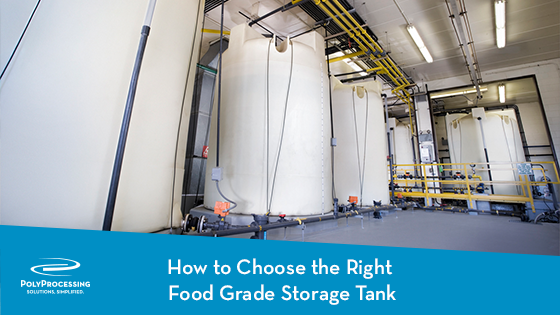How to Choose the Right Food Grade Storage Tank
Once your food production facility outgrows your 300-gallon totes, it’s time to look into larger storage tanks for food storage and clean-in-place chemicals.
There are several options on the market to choose from, but you’ll need to consider which storage tank can meet your greatest challenges: FDA requirements, full-drain capabilities, and cost-effectiveness.

Poly Processing manufactures industry-leading food grade tanks, including food grade water storage tanks. Our cross-linked polyethylene (XLPE) storage tanks are unmatched in the food production industry.
Here’s why.
FDA-compliant Storage Tanks
Customers often ask if our food grade storage tanks are FDA approved. The FDA doesn’t approve tanks or machinery. It approves things that go into food, such as additives. The confusion comes from a misunderstanding between FDA approval and meeting FDA requirements.
 The FDA doesn’t approve equipment used in food processing. Instead, it has a set of requirements that equipment used in food storage and processing must meet. Our tanks meet FDA requirements, and we can provide a letter from an FDA attorney that states our tanks meet all FDA requirements.
The FDA doesn’t approve equipment used in food processing. Instead, it has a set of requirements that equipment used in food storage and processing must meet. Our tanks meet FDA requirements, and we can provide a letter from an FDA attorney that states our tanks meet all FDA requirements.
One word of caution: some tank manufacturers state that their resin meets FDA requirements. But when the resin becomes a tank, it’s a whole other ballgame. Just because a resin meets FDA requirements, that doesn’t mean the manufactured tank will meet them. The tank itself should meet FDA requirements. Our manufactured tanks do that.
Handpicked related content: Dairy, Food, and DEF Storage Tanks That Outlast Other Solutions
100% Full-Drain Tanks
Full-tank drainage is a major challenge for food processing companies because the leftover product can spoil entire batches of food, additives, or clean-in-place (CIP) soaps. It’s important to be able to get all the food or soap out of the tank and start fresh with the next batch.
Some food grade tank manufacturers claim to have full-drain systems, but they don’t actually drain 100 percent of the material. Always make sure that full-drain means 100 percent. The problem lies in the fact that sidewall fittings must be installed above the knuckle radius of the tank. There’s at least a half-inch of the tank below the outlet, preventing full drain.
You should also ask tank manufacturers about metallic inserts, which can create real problems. During production, the tank is molded and a metallic insert is placed in the mold so that the insert gets encapsulated in the sidewall of the tank. Once the tank is finished, they clean it up and put a rubber grommet on the fitting. But the fittings provide opportunities for leak points, and the metallic insert is susceptible to corrosion. Also, because the insert is a different material from the tank, there are two different expansion and contraction rates. Eventually, you’ll can find stress cracking around the metallic insert.
Poly Processing’s innovative vertical IMFO® (Integrally Molded Flanged Outlet) and Slope-Bottom IMFO tanks eliminate all of the challenges of full-drain systems. IMFO tanks place the outlet flange below the bottom sidewall, giving you 100% full drain. You’ll never need to worry about material staying in the bottom of the tank and growing over time. And because the flange is integrally molded into the tank, there are no fittings and no risks of leaks or stress cracking.
Poly Processing has a new line of PolyBase Systems for our vertical IMFO and Slope-Bottom IMFO tanks — a stronger-than-ever chemical tank pad that’s engineered to handle more pressure and larger tanks.
XLPE vs. Stainless Steel Tanks
Is stainless steel a better option than cross-linked polyethylene tanks? Stainless steel is a terrific storage option—especially if you aren’t storing a harsh chemical. In many cases, stainless steel is ideal for meeting pressure and temperature needs.
But it’s also significantly more expensive than an XLPE tank, and it requires ongoing maintenance for the life of the tank. Standard stainless steel has a more porous inner surface than polyethylene with OR-1000™ and is more prone to bacteria growth — bad news if you’re storing food. Polished stainless steel offers a less porous, bacteria-resistant inner tank surface, but it comes at a hefty price. Polished stainless steel can cost 3-6 times more than a comparable polyethylene storage tank.
Cost differences between standard stainless steel and Poly Processing food grade tanks depend on the tank size. A 500-gallon stainless steel tank can be six times more expensive than a Poly tank. A 15,000-gallon tank costs three to four times as much. If cost and ongoing maintenance are a concern for your company, cross-linked polyethylene tanks give you outstanding performance for many years—our customers often report 15 to 20+ years of service.
The Right Choice for Your Food Storage Needs
If you’re looking for an FDA compliant tank that provides 100 percent full-tank drainage at one-tenth the price of polished stainless steel, Poly Processing can help you design a storage system to meet your company’s specific requirements. Contact one of our storage system specialists today.
Photos: U.S. Food and Drug Administration via Wikimedia Commons
- January 19, 2020
- Topics: Chemicals
About Poly Processing
Posts By Topic
Tech Talk Podcast Episodes
Subscribe By Email
Recent Posts
- Maximizing Fill Efficiency: Selecting the Optimal Fill Line System
- Chemical Storage Tanks: A Quick Guide for End Users
- Popular Customization Options for Chemical Storage Tanks
- Understanding Flood Zones Under the IBC: Building Requirements and Insurance Implications
- Choosing Between Steel, Polyethylene, and Fiberglass Tanks: What You Need to Know
Tank Configurator

Find the recommended tank and system components for your chemical storage challenge.
Configure a Tank Package




